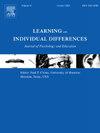The optimal sequence for learning can depend on one's strategy: An individual differences approach
IF 9
1区 心理学
Q1 PSYCHOLOGY, EDUCATIONAL
引用次数: 0
Abstract
Category learning promotes multiple cognitive processes including memorization and induction (e.g., rule finding). Individuals can differ in their reliance on a given process. Would optimal study sequence (interleaving vs. blocking) depend on that process (memorization vs. rule-finding)? Interleaving examples from a category can be better than blocking when the test necessitates similarity-based classification, but blocking examples from a given category can be better when the test necessitates rule-based classification. In three experiments, participants studied letter strings interleaved or blocked. Then they classified transfer items for which similarity-based classification would oppose rule-based classification. In Experiments 1a/1b, participants chose (and self-reported) their learning strategy. In Experiment 2, strategy was instructed. Memorizers (self-reported and instructed) had better similarity-based classification when items were interleaved than when they were blocked, but rule-abstractors (self-reported and instructed) had better rule-based classification when items were blocked than when they were interleaved. These results have implications for educational contexts.
Educational relevance and implications statement
In educational settings, students need to categorize information. From figuring out what formula applies to a given physics problem to learning how to categorize plants in biology to picking out common themes in a literature course, categorization is a necessity. However, people differ in the strategies that they use to learn, with some trying to find rules and some focusing on memorization; these differences in strategy lead to differences in how people classify items. The present results showed that for memorizers, interleaving was more effective for similarity-based classification than was blocking, but for rule-abstractors, blocking was better for rule-based classification than was interleaving. Although the materials in the present studies were relatively simplistic, we argue that these findings could be used to make predictions about learning with educational materials and in educational settings. Teachers should be aware that two individuals could approach a task with qualitatively distinct strategies, so they should clarify their learning goals and sequence learning material in a way that optimizes learning.
学习的最佳顺序取决于一个人的策略:个体差异方法
类别学习促进多种认知过程,包括记忆和归纳(如规则发现)。个体对给定过程的依赖程度可能不同。最佳的学习顺序(交错vs.阻塞)是否取决于这个过程(记忆vs.规则发现)?当测试需要基于相似度的分类时,从一个类别中穿插示例可能比阻塞更好,但是当测试需要基于规则的分类时,从给定类别中阻塞示例可能更好。在三个实验中,参与者研究了交错或阻塞的字母串。然后,他们对基于相似性的分类与基于规则的分类相对立的转移项目进行分类。在实验1a/1b中,参与者选择(并自我报告)他们的学习策略。在实验2中,指导策略。当项目交错时,记忆者(自我报告和指导)的基于相似性的分类优于被阻塞时的分类,但是当项目被阻塞时,规则抽象者(自我报告和指导)的基于规则的分类优于项目交错时的分类。这些结果对教育环境具有启示意义。教育相关性和含义陈述在教育环境中,学生需要对信息进行分类。从找出什么公式适用于给定的物理问题,到学习如何在生物学中对植物进行分类,再到在文学课程中挑选共同的主题,分类是必要的。然而,人们使用不同的策略来学习,有些人试图找到规则,有些人专注于记忆;这些策略上的差异导致了人们对物品分类方式的差异。结果表明,对于记忆者而言,交错法对基于相似性的分类效果优于阻塞法,而对于规则抽象者而言,阻塞法对基于规则的分类效果优于交错法。虽然目前研究中的材料相对简单,但我们认为这些发现可以用来预测使用教材和在教育环境中学习的情况。教师应该意识到,两个人可能会用不同的策略来完成一项任务,因此他们应该明确自己的学习目标,并以一种优化学习的方式对学习材料进行排序。
本文章由计算机程序翻译,如有差异,请以英文原文为准。
求助全文
约1分钟内获得全文
求助全文
来源期刊

Learning and Individual Differences
PSYCHOLOGY, EDUCATIONAL-
CiteScore
6.60
自引率
2.80%
发文量
86
期刊介绍:
Learning and Individual Differences is a research journal devoted to publishing articles of individual differences as they relate to learning within an educational context. The Journal focuses on original empirical studies of high theoretical and methodological rigor that that make a substantial scientific contribution. Learning and Individual Differences publishes original research. Manuscripts should be no longer than 7500 words of primary text (not including tables, figures, references).
 求助内容:
求助内容: 应助结果提醒方式:
应助结果提醒方式:


